| No. | Portrait | Name
(born-died) | Term of office | Notes |
|---|
| Took office | Left office | Time in office |
|---|
| 1 |  | Captain
Leonard G. Shepard | 14 December 1889 | 14 March 1895 | 5 years, 90 days | Shepard became the first military Chief of the "Revenue-Marine Division" of the Treasury Department and is considered to be the first Commandant. [5] |
| 2 |  | Captain
Charles F. Shoemaker | 19 March 1895 | 27 March 1905 | 10 years, 8 days | On 8 May 1908, Shoemaker was promoted to the rank of Captain-Commandant on the Retired List by Act of Congress. |
| 3 | 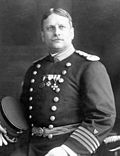 | Captain-commandant
Worth G. Ross | 25 April 1905 | 30 April 1911 | 6 years, 5 days | Ross was instrumental in the establishment of what was to become the U.S. Coast Guard Academy in New London, Connecticut. |
| 4 |  | Commodore
Ellsworth P. Bertholf | 19 June 1911 | 30 June 1919 | 8 years, 11 days | Served during the merger of the U.S. Revenue Cutter Service with the U.S. Life-Saving Service to form the U.S. Coast Guard. Was the first Coast Guard officer to achieve flag rank. [Note 1] |
| 5 |  | Rear Admiral
William E. Reynolds | 2 October 1919 | 11 January 1924 | 4 years, 101 days | Reynolds was the first Coast Guard officer to be promoted to the rank of rear admiral. |
| 6 | 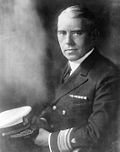 | Rear Admiral
Frederick C. Billard | 11 January 1924 | 17 May 1932 | 8 years, 127 days | Billard was appointed to three consecutive terms as Commandant and died in office 17 May 1932, serving through the Prohibition Era and reorganization of the academy. |
| 7 | 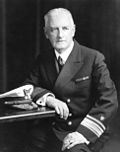 | Rear Admiral
Harry G. Hamlet | 14 June 1932 | 14 June 1936 [7] | 4 years, 0 days | Hamlet persuaded Congress to dismiss efforts to merge the Coast Guard with the U.S. Navy. Continued serving after term as Commandant was over and eventually retired as a vice admiral by act of Congress. |
| 8 | 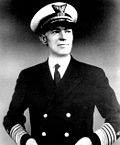 | Admiral
Russell R. Waesche | 14 June 1936 [8] | 1 January 1946 | 9 years, 201 days | First Commandant to be promoted to vice admiral and admiral. Commandant during World War II and helped the Coast Guard remain a separate distinct service while it was assigned to the U.S. Navy. Oversaw the largest manpower buildup in Coast Guard history and was instrumental in the formation of the U.S. Coast Guard Auxiliary and the U.S. Coast Guard Reserve. [Note 2] |
| 9 |  | Admiral
Joseph F. Farley | 1 January 1946 | 1 January 1950 | 4 years, 0 days | Farley served during the difficult Post-World War II era when additional statutory responsibilities were being added to the Coast Guard's mission structure and personnel allowances were being reduced. |
| 10 | 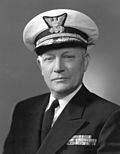 | Vice Admiral
Merlin O'Neill | 1 January 1950 | 1 June 1954 | 4 years, 151 days | O'Neill directed the increase in port security activities required by the passage of the Magnuson Act and revitalized the Coast Guard Reserve program emphasizing its defense mission during wartime. [Note 3] |
| 11 |  | Admiral
Alfred C. Richmond | 1 June 1954 | 1 June 1962 | 8 years, 0 days | Richmond served two full terms as Commandant and was the United States delegate to many international maritime conferences during his tenure. [Note 4] |
| 12 | 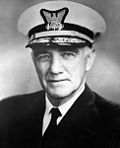 | Admiral
Edwin J. Roland | 1 June 1962 | 1 June 1966 | 4 years, 0 days | Roland oversaw the replacement of many World War II era cutters under fleet modernization programs during his tenure. He assisted the U.S. Navy with operations in Vietnam by supplying crews and cutters for Operation Market Time. |
| 13 |  | Admiral
Willard J. Smith | 1 June 1966 | 1 June 1970 | 4 years, 0 days | Smith was the Commandant of the Coast Guard when the service was transferred from the Department of the Treasury to the newly formed Department of Transportation. |
| 14 |  | Admiral
Chester R. Bender | 1 June 1970 | 1 June 1974 | 4 years, 0 days | The Coast Guard undertook new statutory responsibilities in the areas of marine safety, environmental protection and law enforcement during his tenure, however Bender is best known for his changes in the dress uniform worn by Coast Guardsmen; sometimes referred to as "Bender's Blues". |
| 15 |  | Admiral
Owen W. Siler | 1 June 1974 | 1 June 1978 | 4 years, 0 days | Several changes in environmental duties occurred during Siler's tenure as well as a step-up in drug interdiction activities. Under his tenure, the replacement of aging cutters was given budget priority, and the first women entered the Coast Guard Academy. |
| 16 |  | Admiral
John B. Hayes | 1 June 1978 | 28 May 1982 | 3 years, 361 days | Hayes experienced severe budget problems during his tenure while fending off a move in Congress to transfer the Coast Guard to the Navy. Drug interdiction was increased and several high-profile search and rescue cases occurred during his watch which helped keep the Coast Guard in the public eye. |
| 17 |  | Admiral
James S. Gracey | 28 May 1982 | 30 May 1986 | 4 years, 2 days | Gracey faced tight budgets at the same time he was successful at replacing aging cutters. Increasing the Coast Guard's role in the defense of coastal waters was accomplished. |
| 18 |  | Admiral
Paul A. Yost Jr. | 30 May 1986 | 31 May 1990 | 4 years, 1 day | Yost successfully maintained the service through difficult budget battles each year. In doing so, he also emphasized three 'primary mission areas": maritime law enforcement, maritime safety, and defense readiness. There was an increased emphasis on military/naval capabilities of the service. |
| 19 | 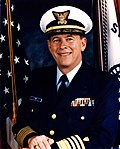 | Admiral
J. William Kime | 31 May 1990 | 1 June 1994 | 4 years, 1 day | Kime led the service during the end of the Cold War, collapse of the Soviet Union, the Persian Gulf War's Operations Desert Shield and Desert Storm, as well as increasing operations in drug interdiction and environmental law enforcement. |
| 20 |  | Admiral
Robert E. Kramek | 1 June 1994 | 30 May 1998 | 3 years, 363 days | During his tenure as Commandant, he successfully led the service through difficult budget battles each year and directed the "streamlining" plan that was mandated by the National Performance Review and "Mandate for Change." |
| 21 |  | Admiral
James Loy | 30 May 1998 | 30 May 2002 | 4 years, 0 days | As the USCG Commandant, Loy reacted to the September 11 attacks of 2001. In the short term, he supervised the resumption of sea-borne trade throughout the U.S., after the USCG had shut down most major ports after the attacks. In the long term, Loy led the U.S. delegation to the International Maritime Organization (IMO), and was instrumental in ensuring that the International Ship and Port Facility Security Code was approved and implemented in 2002. The code came into effect in 2004. |
| 22 |  | Admiral
Thomas H. Collins | 30 May 2002 | 25 May 2006 | 3 years, 360 days | Collins guided the U.S. Coast Guard in the aftermath of the September 11 attacks of 2001. As part of this effort to tighten maritime security, Collins encouraged people involved in the maritime industry and the recreational boating industry to report suspicious activity to the National Response Center. This program was extended and formalized as America's Waterway Watch in 2005. |
| 23 |  | Admiral
Thad W. Allen | 25 May 2006 | 25 May 2010 | 4 years, 0 days | Allen led the effort to reform and modernize all aspects of the Coast Guard, improving and sustaining Mission Execution. Admiral Allen continually stated his ultimate aim was to make the Coast Guard a "change-centric" organization capable of quickly and efficiently adapting to meet the growing and ever-changing demands of the future. Additionally he was the first high-ranking member of the Federal government to embrace social media, pioneering the effort to connect to his audience through all manners of digital technology. During his final months in office he led the Coast Guard's exemplary response to the earthquake in Haiti and then, first as Commandant and concurrently as the National Incident Commander, he led the nation's response to the Deepwater Horizon oil spill, holding the latter post well after his tenure as Commandant had come to a close. |
| 24 |  | Admiral
Robert J. Papp Jr. | 25 May 2010 | 30 May 2014 | 4 years, 5 days | |
| 25 |  | Admiral
Paul F. Zukunft | 30 May 2014 | 1 June 2018 | 4 years, 2 days | |
| 26 |  | Admiral
Karl L. Schultz | 1 June 2018 | 1 June 2022 | 4 years, 0 days | |
| 27 |  | Admiral
Linda L. Fagan | 1 June 2022 | 21 January 2025 | 2 years, 234 days | Fagan is the first woman to serve as Coast Guard Commandant, and simultaneously the first woman to lead a military branch in the United States. |
| – |  | Admiral
Kevin E. Lunday | 21 January 2025 | 18 December 2025 | 331 days | Served as acting commandant from January-December 2025 before being confirmed by the Senate to the office. |
| 28 | 18 December 2025 | Incumbent | 11 days | |
































